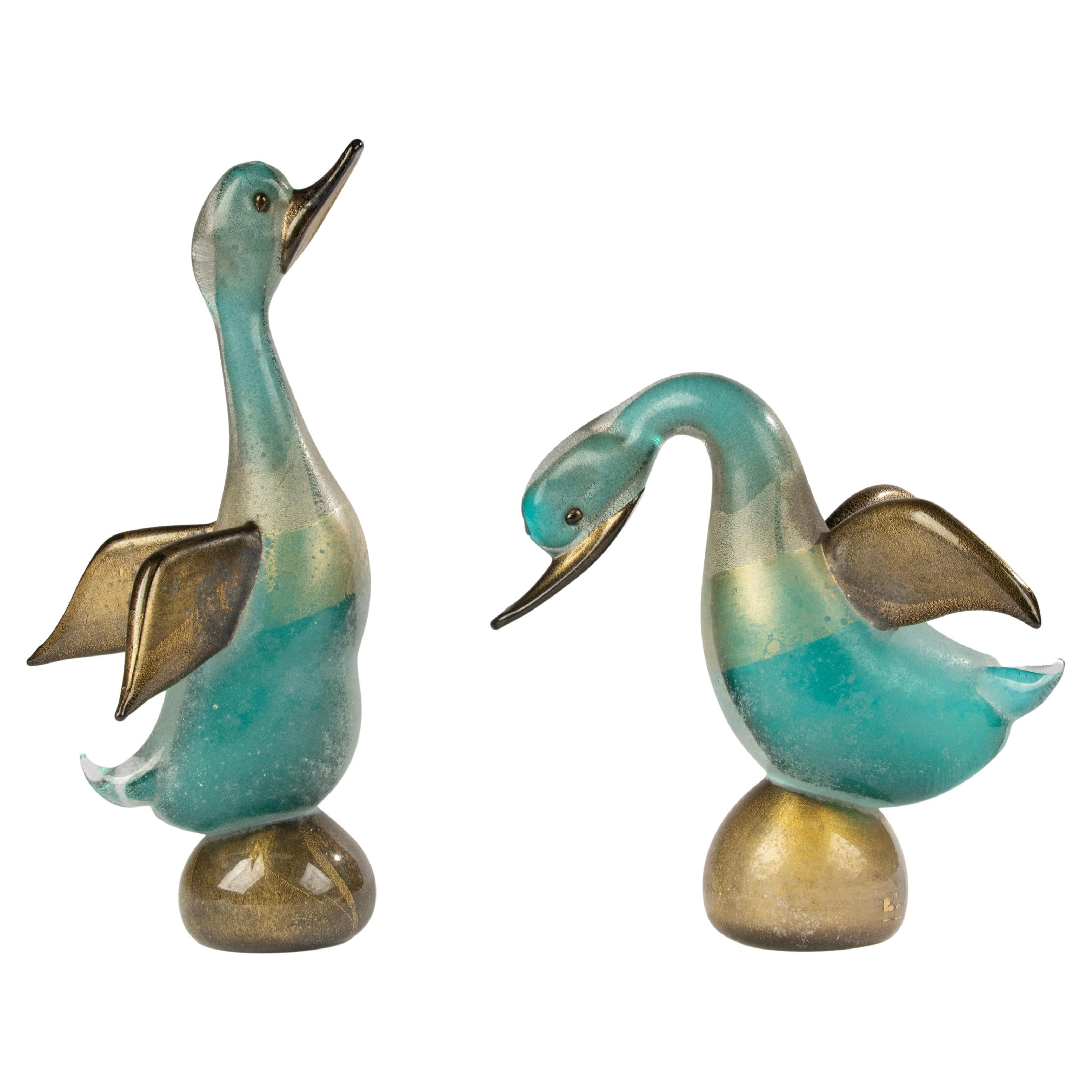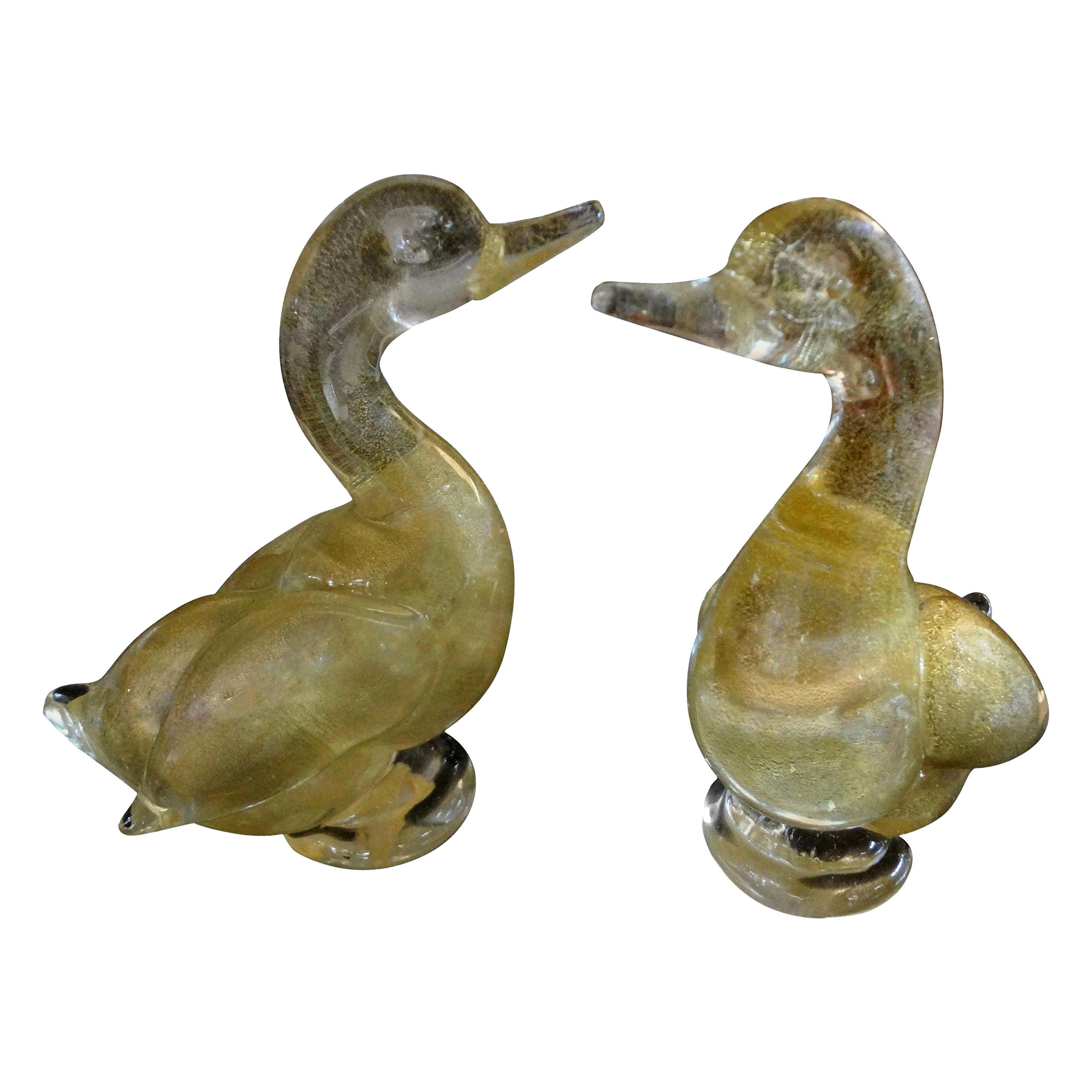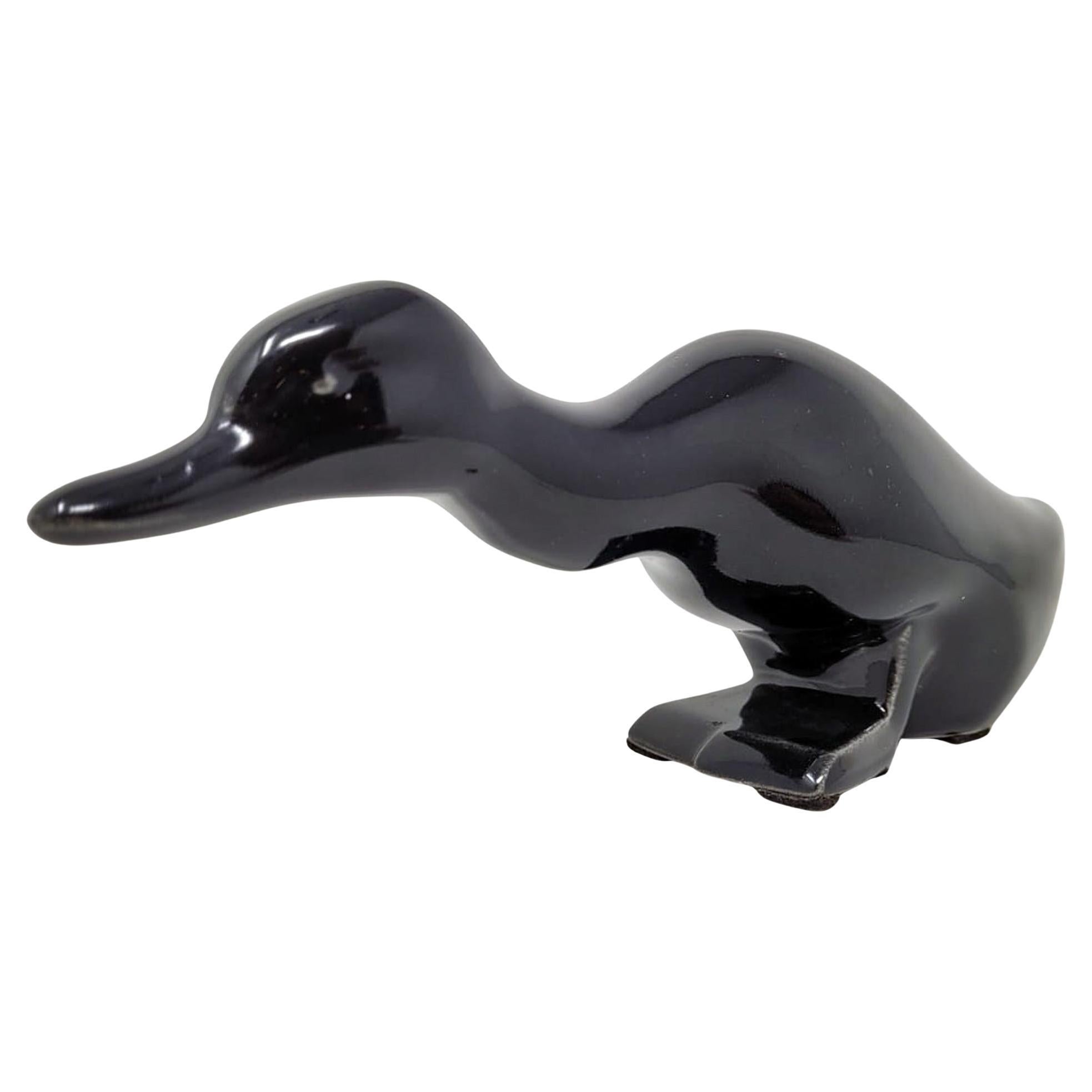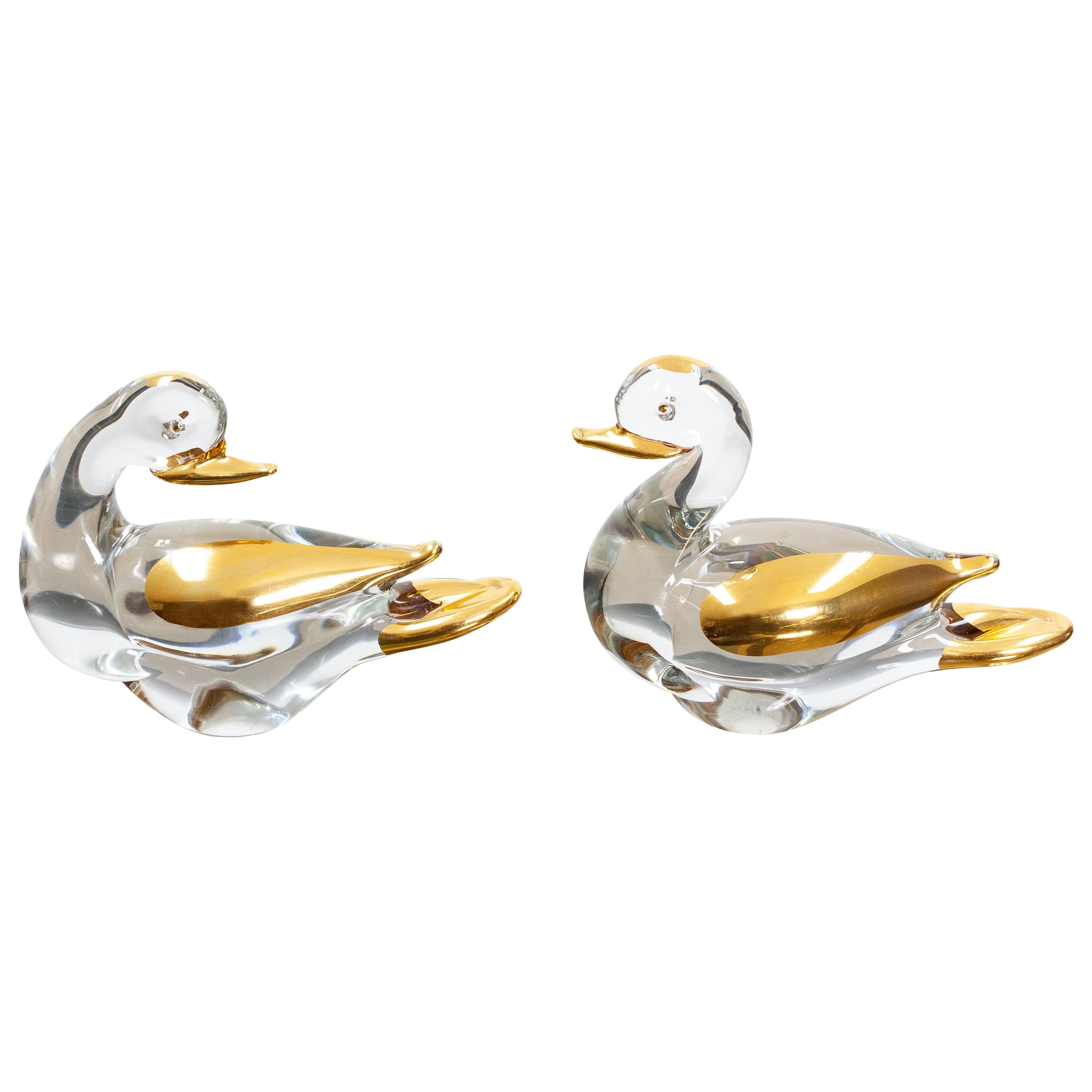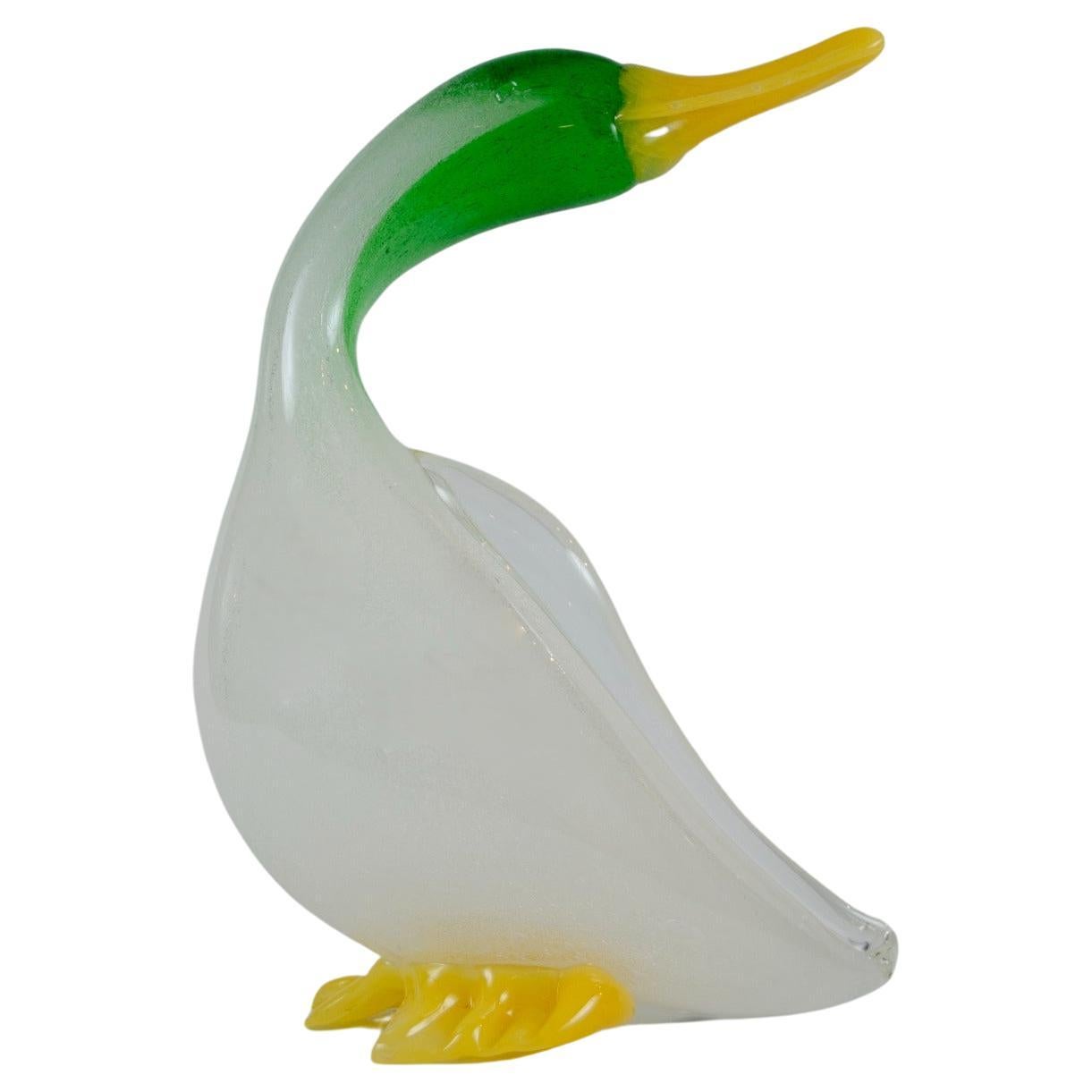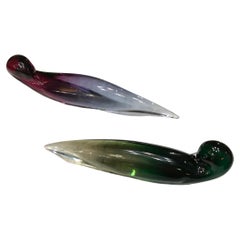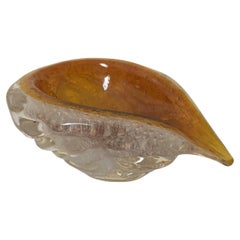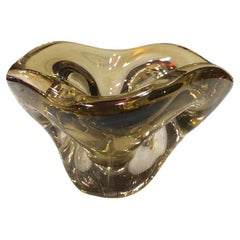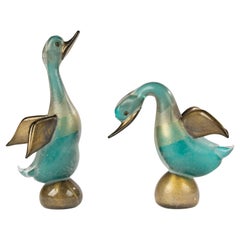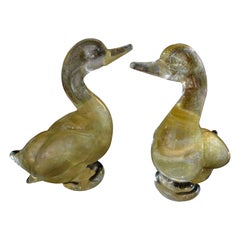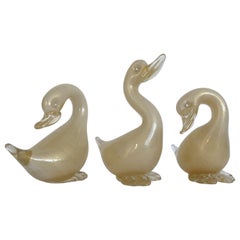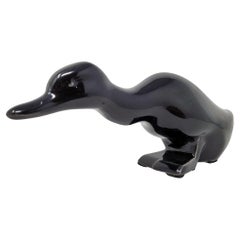Items Similar to Ducks Murano, 1940, Italian, Attributed to Seguso, Barovier
Video Loading
Want more images or videos?
Request additional images or videos from the seller
1 of 17
Ducks Murano, 1940, Italian, Attributed to Seguso, Barovier
$4,100
£3,114.05
€3,597.76
CA$5,746.30
A$6,431.19
CHF 3,356.59
MX$78,427.35
NOK 42,959.73
SEK 40,666.89
DKK 26,849.59
Shipping
Retrieving quote...The 1stDibs Promise:
Authenticity Guarantee,
Money-Back Guarantee,
24-Hour Cancellation
About the Item
Murano with gold
We have specialized in the sale of Art Deco and Art Nouveau and Vintage styles since 1982. If you have any questions we are at your disposal.
Pushing the button that reads 'View All From Seller'. And you can see more objects to the style for sale.
Attributed to Seguso - Barovier
We have specialized in the sale of Art Deco and Art Nouveau and Vintage styles since 1982. If you have any questions we are at your disposal.
The history of "Seguso Vetri D' Arte" is directly linked to the "Vetreria Artistica Barovier" company. When the Barovier workshop was forced to reduce production in 1929, due to a financial crisis in America, the
original group of ten partners had to separate and Antonio Seguso in 1931, assisted by his sons Ernesto and Archimede opened a small workshop of his own. They were joined by Luigi Olimpio Ferro and Napoleone Barovier the following year. Together the craftsmen establish the "Artistica Soffieria e Vetreria Barovier Seguso & Ferro" company as equal partners.
In 1934 Flavio Poli joins the firm as artistic director and within only a brief period of time a distinct style of designs emerged. The close collaboration between Flavio Poli, Archimede Seguso and Alfredo Barbini played an important part in the success of the company. New glass techniques are developed which include never before seen color applications.
The companies innovative designs constantly received awards and during the 1935 World Fair in Brussels and the 1936 Milan Triennale they did attract the interest of a new group of clientele. One of them is the French wholesale company "Veronese" from Paris which would play a defining role in the history of the company.
The demand for an increase in production requires additional investments and the partners felt that there is a need to multiply their investment tenfold.
Luigi Olimpio Ferro subsequently decided to withdraw from the company and his shares are acquired by Flavio Poli, which makes him a full partner. As a result, the company name is changed to Seguso Vetri D’ Arte and it is officially recognized in 1937. A period of great success and prosperity ensues, lasting until the outbreak of World War II.
The post war period is a time of great change in Europe and the rebuilding of the economical structure in Italy requires major investments which result in the introduction of new import duties and taxes.
To safeguard the copyright of the Seguso Vetri D'Arte designs an application for a second entry into the commercial registers of Venice is made by the partners in 1945.
Strict export regulations curb international business relations for many years after the war and the company decides to focus on the domestic market instead. In 1946 a large retail location is opened at the Piazza Diaz in Milan where in addition to the art glass, German porcelain and Italian pottery is offered.
In 1950 Flavio Poli develops a new sommerso glass technique, which consists of an overlaying of transparent layers of glass. The overlapping creates new shades of color which prior to the introduction of this technique had not been seen. Flavio Poli's most iconic design is the "Valve", which resembles an upright, slightly opened clam shell. The design was introduced in 1951. Mario Pinzoni joins the company in 1953 as a personal assistant to Flavio Poli and his responsibilities as a draftsman included the compilation of archival and the existing production drawing s into in a single company catalogue. The continuous increase in prosperity during the 1950s brings financial security to the glass company and Flavio Poli once more sets out to experiment with new glass techniques. Contrary to the preceding series of "Sommersi" objects, none of the new series become commercially successful, and the production is soon abandoned. Poli returns to develop additional sommersi designs with new colour applications including topaz and sapphire shades of color combined with violet which is introduced during the Biennale in 1957. A shift in ownership due to the passing of Napoleone Barovier and the withdrawal of Antonio Seguso, put Ernesto Seguso and Flavio Poli at the head of the company management. Conflicts with Bruno and Angelo Seguso concerning artistic direction cause Flavio Poli to resign in 1963 and Mario Pinzoni takes over the artistic leadership. He introduces new colors and models, yet maintains the basic "sommerso" technique which has become the company’s trademark. The costly production of these objects and and an increase in competition cause the once so solid structure of the company to collapse. Pinzoni decides to leave the company in 1971, and Vittorio Rigattieri is hired yet he is unable to turn the tide. In 1973 Seguso Vetri D’Arte ceases its production. The hiring of Maurizio Albarelli in 1978 proves as saving grace of the Seguso Vetri D' Arte company archives which were therefore preserved and which nowadays belong to the Fondazione Cini on San Giorgi and the Seguso family on Murano.
Why are there so many antiques in Argentina?
In the 1880 – 1940 there was a grate wave of immigration encouraged by the periods of war that were taking place.
1st World War took place between 1914 and 1918
2nd World War took place between 1939 and 1945
The immigrants options were New York or Buenos Aires. Tickets were cheap and in Buenos Aires they were welcomed with open arms, as it was a country where everything was still to be done.
Argentina was the country of new opportunities, labour was needed and religious freedom was assured, in many cases the of the family travel first until they were settled and then the rest of the family members join them.
In the immigrant museum “Ellis Island Immigrant Building” in New York you can se the promotional posters of the boats that would take them to a new life.
Between the years 1895 and 1896, Argentina had the highest DGP (gross domestic product) per capita in the world according to the Maddison Historical Statistics index, this situation arose due to the large amount of food being exported to European countries, which were at war.
The Argentinean ships left the port of Buenos Aires with food, but they returned with furniture, clothes and construction elements, (it´s common to see this the old buildings of the historic neighbourhood of San Telmo, the beams with the inscription “Made in England)”, as well as many markets that were built in Buenos Aires, such us the San Telmo Market, whose structure was brought by ship and afterwards assembled in 900 Defensa Street.
With the great influence of European immigrants living in the country, the children of the upper classes travelled to study in France, resulting in the inauguration of “La Maison Argentinienne”, on 27th of June 1928, in the international city of Paris, which hosted many Argentinians that were studying in Frace.
It´s the fourth house to be built after France, Canada and Belgium, being the first Spanish-speaking one. Still in place today (17 Bd Jourdan, 75014, Paris, France). Many of the children of these wealthy families who attended international art exhibitions, museums and art courses abroad, took a keen interest in the European style. This is why Buenos Aires was at the time referred as “The Paris of South America”.
Between the years 1890 and 1920 more than a hundred Palaces were built on Alvear Avenue the most exclusive avenue in Buenos Aires. Today some of these palaces have been transformed into museums, hotels and embassies.
In the year 1936, the Kavanagh building was inaugurated, it was the tallest reinforced concrete building in South America.
During 1994 the American Society of Civil Engineers distinguished it as an “international engineering milestone”, and it´s now considered a World Heritage of Modern Architecture.
At the time was common to hire foreign architects such as Le Corbusier, who visited Buenos Aires/Argentina in 1929 and in 1948 he drew up the blueprints for a house built in La Plata City (which was declared a World Heritage Site).
In 1947, the Hungarian architect Marcelo Breuer designed “Parador Ariston” in the seaside city of Mar del Plata. After an Argentinean student at Harvard University convinced him to come to Argentina. He worked on an urban development project in the Casa Amarilla, area of La Boca.
The Ukrainian architect, Vladimiro Acosta, arrives in Argentina in 1928 and worked as an architect until que moved to Brazil.
Antonio Bonet, a Spanish architect who worked with Le Corbusier in Paris, arrives in Argentina in 1937, where he carried out several architectural works and in 1938 designs the well-known BFK chair.
Andres Kálnay, of Hungarian origin, made around 120 architectural masterpieces, among which the former Munich brewery stands out, he even made the furniture’s design.
The German architect, Walter Gropius, director of the Bauhaus, lived in Argentina, where he wrote articles for “Sur” magazine and founded in Buenos Aires, an architectural firm with Franz Möller, who was also an architect, where he built two houses.
At the same time several famous designers decided to immigrate to Argentina, among them we can find the well-known French designer, Jean-Michel Frank, who arrived in the country in 1940 and also worked for the Rockefeller family.
Special pieces were made, which were sold exclusively in the country, such as the well-known German company “WMF”, who sold their products by catalogue, which were chosen by the ladies of high society in the list of wedding gifts, as well as the pieces designed by Christofle.
The Swiss sculptor Alberto Giacometti, made special pieces for Argentinean mansions.
In 1904 the first Jansen branch outside Paris was established in Buenos Aires, as the Argentinean clientele demanded a large amount of furniture, from the end of the 19th century to the mid-20th century.
In 1970, the brand Rigolleau Argentina made pieces authorised by Lalique.
The brands Maple and Thompson also set up shop in the country.
The French plastic artist, Marcel Duchamp moved to Argentina in 1918-1919.
Glass signed Gallé, Charder, Leverre, Schneider, Muller and other French firms. They were bought in flower shops and were given to ladies with beautiful floral arrangements.
Some furniture manufacturers travelled to international fairs and bough the patterns to produce the furniture in Argentina, such as the furniture firm Englander and Bonta, who bought the patterns ins Italy.
It is worth mentioning that in Argentina we have the largest community of Italians outside of Italy, as it is estimated that 70 percent of the inhabitants have at least one Italian descendant, followed by Spanish immigrants.
The most Important furniture stores in Argentina:
Comte is founded in 1934 (under the direct management of Jean Michel Frank in 1940).
Nordiska (Swedish company established in 1934).
Churba in 1960, a company that brought foreign designers to present their furniture in the country:
Denmark: (Arne Jacobsen, Finn Juhl, Bender Madsen, Ejner Larsen, Poul Kjaerholm, Hans Wegner)
Sweden: (Hans Agne Jakobsson, Gustavsberg)
United States: (Herman Miller)
Finland: (Lisa Johansson, Folke Arstrom, Tapio Wirkkala, Alvar Aalto, Timo Sarpaneva)
Swedish Factory: (Orrefors)
Italy: (Littala, Vico Magistretti, Emma Gismondi, Gae Aulenti, Angelo Mangiarotti, Elio Martinelli, Gianna Celada, Angelo Mangiarotti, Mario Bellini, Carlo Scarpa)
Finland: (Olivia Toikka)
Plata Lappas (Lappas Silver): a goldsmith shop founded in 1887 in Argentina by Alcibiades Lappas of Greek origin.
In 2019, in Argentina took place “the Art Deco world congress”, in which we participated as hosts invited by Geo Darder, founder of the Copperbridge – Foundation, in which prominent people from all over the world attended to learn about Art Deco in Argentina.
Argentina currently has more than 100 Art Deco buildings and another 90 Art Nouveau buildings throughout the city of Buenos Aires.
Argentina is a country that has not been involved in many wars, which is why it has been a refuge for works of art and antiques from different periods of time, unlike European countries. That is way many collectors, museums and antique dealers from all over the world visit it, you should not miss the opportunity to visit this great country.
Laura Guevara Kjuder, architect.
- Attributed to:Barovier Seguso & Ferro (Designer)
- Dimensions:Height: 4.73 in (12 cm)Width: 5.91 in (15 cm)Depth: 3.94 in (10 cm)
- Style:Art Deco (Of the Period)
- Materials and Techniques:
- Place of Origin:
- Period:
- Date of Manufacture:1940
- Condition:Wear consistent with age and use.
- Seller Location:Ciudad Autónoma Buenos Aires, AR
- Reference Number:Seller: MU-421stDibs: LU6785231844472
About the Seller
5.0
Vetted Professional Seller
Every seller passes strict standards for authenticity and reliability
Established in 1982
1stDibs seller since 2022
37 sales on 1stDibs
Typical response time: <1 hour
- ShippingRetrieving quote...Shipping from: Ciudad Autónoma Buenos Aires, Argentina
- Return Policy
Authenticity Guarantee
In the unlikely event there’s an issue with an item’s authenticity, contact us within 1 year for a full refund. DetailsMoney-Back Guarantee
If your item is not as described, is damaged in transit, or does not arrive, contact us within 7 days for a full refund. Details24-Hour Cancellation
You have a 24-hour grace period in which to reconsider your purchase, with no questions asked.Vetted Professional Sellers
Our world-class sellers must adhere to strict standards for service and quality, maintaining the integrity of our listings.Price-Match Guarantee
If you find that a seller listed the same item for a lower price elsewhere, we’ll match it.Trusted Global Delivery
Our best-in-class carrier network provides specialized shipping options worldwide, including custom delivery.More From This Seller
View AllDucks Murano, 1930, Italian, Sing Salviati & C
By Salviati
Located in Ciudad Autónoma Buenos Aires, C
Murano
We have specialized in the sale of Art Deco and Art Nouveau and Vintage styles since 1982. If you have any questions we are at your disposal.
Pushing the button that reads 'View All From Seller'. And you can see more objects to the style for sale.
Salviati & C
Measures: Violet : 33 long x 10 high x 5.5 depth
Green: 30 long x 9 high x 5.5 depth
The lawyer Antonio Salviati and his dream
In 1859 in his premises at Number 731 of Dorsoduro, Venice the “Salviati Dott. Antonio fu Bartolomeo” company was established. This is when, Vicenza-born lawyer Antonio Salviati started the entrepreneurial career, moved by a passion for the precious mosaics of the Basilica of San Marco and fascinated by Murano glass art, he decided to start-up his own production of mosaics and objects in Murano glass.
An ambitious and far-sighted goal pushed him along this path: to revive the fate of Murano glass production that has been fallen for decades.
A challenge which finds the maximum support from two fundamental figures in the history of Murano glass: the mayor of the island, Antonio Colleoni, and the Abbot Vincenzo Zanetti, founder of the glass museum and of the first art school for glass masters.
The first successes and international investments
The launchpad was the “First Glassmakers’ Exhibition” in 1864 in which Salviati participated with a monumental mosaic that earns him a prize superior to the Gold Medal. The success achieved affirmed the credibility of the Company which thus started its glass production in Palazzo da Mula.
The new corporate and productive reality needed investors and the lawyer started to internationalise the company by addressing the economic and financial market across the Channel.
The UK immediately showed huge interest in Salviati’s mosaics – as testified by the mosaic that can be seen on the façade of the current Apple Store in Regent Street, London. It was also in London, on 21st December 1866, that the “Società Anonima per Azioni Salviati & C.” was established with the support of diplomat Sir Austen Henry Layard and historian William Drake. The new corporate set-up was further established with the purchase of a new headquarter, this time on the Riva dei Vetrai in Murano.
The universal show of Paris in 1867 celebrated the relaunch project of Antonio Salviati
“Venice owes a debt of gratitude to the knight Salviati in the resurgence for one of the most legitimately famous of its industries”. From Esposizione Illustrata di Parigi, 1867 pg. 275.
“Venice and Italy have gain huge success in the Universal Exhibition. The resurgence of one of the city’s most famous industries is consecrated in this very occasion by the gold medal awarded by the jury to Mr Salviati […] the crowd […] is gathering around the display cases that hold those pieces of glass that are so transparent and so light as to appear like woven air, impregnated, when in their elegant forms that become rainbows of those iridescent reflections that cover them at the artist’s whim – the author of a real ray of sunshine from the beautiful and splendid Venice”. From Esposizione Illustrata di Parigi, 1867 pg. 311
The fundamental role of training in murano glass
Training plays a fundamental role for the Company; attendance at the Art School was made compulsory for “[…] all the young workers of the Factory who don’t only tire themselves in manual work. This was established with the idea not only to lift their dignity and their initially limited aspirations, […] but also to improve their artistic education and thereby facilitate an improvement also in their economic situation”.
Together with the art school, a free school was also set up to teach all employees to read and write.
Diversification in production and made-to-measure projects
In a short time, Salviati & C. diversified its production to include glasses, cups, amphoras, and vials which guaranteed the first prize in the universal exhibition for three consecutive years.
Its mosaic production also flourished, being used in world-class projects: from the Houses of Parliament in London, to the Viceroy’s palace in Alessandria in Egypt, to the Opera House of Paris, including the private homes of wealthy New York personality.
The entire 19th century for Salviati & C. was represented by development, success and fame in the national and international markets, and the Company became a symbol and reference point of Murano glass art throughout the world.
The Salviati legacy at the turn of the century
On the death of Antonio Salviati in 1890, first his three children followed one another at the helm of the company and then Maurizio Camerino, previously general manager. It was thanks to him that the decorative mosaic project of the Stanford Memorial Church in Palo Alto (California, USA) took place after 12 years of work. As well as the opening of a sales point in Via Montenapoleone in Milan and the institution of a museum collection of Murano glass from the 19th and 20th centuries.
The post-war years, biennials and lighting
After Maurizio Camerino’s death in 1931, his three children took over the helm of the company: its solid foundations allowed them to strive for new important goals in the art world, participating in the Biennials of 1932 and 1934.
Not even the Second World War could tarnish the strength of the Salviati brand: in the post-war years Renzo Camerino renewed the ruined production headquarter and enthusiastically restored all his commercial contacts. Thanks to his grandson Renzo Tedeschi (newly graduated in Engineering at the Polytechnic of Turin and upon his return from an apprenticeship in the United States), Salviati launched its production in lighting appliances.
The following years saw intense growth in the number of collaborations with renowned artists and designers. In 1959, the production site was moved to Fondamenta Radi 16, where it still stands today.
The great lighting projects
The larger production area allowed the company to further expand the international market in the field of architectural lighting.
A number of projects were undertaken, such as the 9-tonne, 22-metres high chandelier in the Chamber of Commerce in Parma, the ceiling illumination in the premises of the World Intellectual Property Organisation in Geneva and the Kowloon Hotel in Hong Kong; not to mention the sound-absorbing windows of the Aula Nervi in the Vatican and the lighting system of the great honour hall of the Philippine Plaza Hotel in Manila in collaboration with architect John Marsteller.
The reputation of Salviati & C. was further affirmed by the commission – after an international call for bids – for twelve 11-metre high chandeliers for the Tonhalle concert hall in Dusseldorf, made using an innovative system of modular glass elements – “LS- System” – one of the today company’s cornerstones.
Salviati from the modern age to the present
The story of Salviati continues in the modern era, keeping the focus on creating an innovative style that had distinguished it since its inception. Participation in international exhibitions increased, such as the Venice Biennials from 1958 to 1972 (the final year in which Murano glass was allowed) thanks to projects by designers of the calibre of Betha and Teff Sarasin, Claire Falkestein, and Luciano Gaspari.
In 1962 Salviati was awarded with the highest recognition in the Design world, the “Compasso d’Oro” prize assigned by A.D.I. for the Marco vase designed by architect Sergio Asti.
In 1965 the company changed its name to Salviati & C. s.p.a.; then it was purchased by the Gruppo Ferruzzi in 1987 which later on it was transferred to a French company.
Since 2015 the company returned to be Venetian with the acquisition by the Umana group.
Salviati and its designers
Salviati’s designers:
Luciano Gaspari, Sergio Asti (Compasso d’Oro 1962), Claire Falkenstein, Ward Bennet, Teff and Betha Sarasin, Ingo Maurer, Ross Lovegrove, Amanda Levete, Tom Dixon, Nigel Coates, Thomas Heatherwick, Luca Nichetto, Ben Gorham...
Category
Vintage 1930s Italian Art Deco Animal Sculptures
Materials
Murano Glass
$3,500 / set
Murano, 1940, Italian
Located in Ciudad Autónoma Buenos Aires, C
Murano
We have specialized in the sale of Art Deco and Art Nouveau and Vintage styles since 1982. If you have any questions we are at your disposal.
Pushing the button that reads 'V...
Category
Vintage 1940s Italian Art Deco Ashtrays
Materials
Murano Glass
$2,125
1930, Italian Murano
Located in Ciudad Autónoma Buenos Aires, C
Murano
We have specialized in the sale of Art Deco and Art Nouveau and Vintage styles since 1982. If you have any questions we are at your disposal.
Pushing the button that reads 'Vi...
Category
Vintage 1930s Italian Art Deco Centerpieces
Materials
Murano Glass
$1,400
Murano, 1940, Italian
Located in Ciudad Autónoma Buenos Aires, C
Murano
We have specialized in the sale of Art Deco and Art Nouveau and Vintage styles since 1982. If you have any questions we are at your disposal.
Pushing the button that reads 'V...
Category
Vintage 1940s Italian Art Deco Ashtrays
Materials
Murano Glass
Murano, Italian, Attributed to Barovier Toso, 1940
By Vetreria Artistica Barovier & C.
Located in Ciudad Autónoma Buenos Aires, C
Murano with gold
We have specialized in the sale of Art Deco and Art Nouveau and Vintage styles since 1982. If you have any questions we are at your disposal.
Pushing the button that reads 'View All From Seller'. And you can see more objects to the style for sale.
Attributed to Barovier Toso
We have specialized in the sale of Art Deco and Art Nouveau and Vintage styles since 1982.
The company is one of the oldest family businesses in the world, founded in 1295 as Barovier. "The name Barovier derives from the term berroviere (highwayman/policman , which indicates the armigero (person entitled to bear arms guarding the captain of the people. It is probable that some Barovier, originally from Treviso, settled in Murano around 1291, when a law of the Republic imposed the concentration on the island of all glass furnaces." Jacobello was the first member of the Barovier family to work glass at this time. It is thought that the company originated in Treviso[citation needed]. The Toso family had been established in Murano since around 1350. In the 1400s Angelo Barovier created glass objects which are currently preserved in various museums.[6] Angelo is recognized as significant for uniting the knowledge which had been developed and handed down by family Barovier. He was not only considered and artist but a scientist.
The company became Ferro Toso Vetrerie Artistiche Riunite S.A in 1936 when Vetreria Artistica Barovier merged with Ferro Toso, specializing in crystalline glass, mother-of-pearl glass, and gold-free cornelian red glass. In 1942, the company was renamed Barovier & Toso.
In 1919–1920, 30 year old designer Ercole Barovier began a 50-year career as the artistic director of Barovier & Toso. "After studying medicine and working as a radio operator during World War One he joined the family firm in 1920 when he and his brother Nicolo took over the management from their father Benvenuto. From 1927 Ercole was the main designer and from 1934, when Nicolo left the company, (he was) also the sole owner." While Barovier did not have formal training as a glassblower, his artistic designs produced objets d'art that have become the most critically acclaimed in the history of Ercole - Barovier.[9] In 1930 he produced his award-winning “Primavera” series. "The Primavera series ... is distinguished by a milky white 'craquelé' glass with the addition of black or blue pasta vitrea trim ("opaque colored glass whose consistency is made to appear like ceramic") and decoration. There was a very limited production of this series due to the fact that it was a result of a glass mixture obtained accidentally so it could never be replicated."[13] One example of this series, a Primavera Pigeon, was sold at auction for GBP 275,000 (approximately $360,000 USD, not inclusive of the buyer’s premium) on October 16, 2019.
Barovier continued to produce innovative designs of which the “Lenti” vase...
Category
Vintage 1940s Italian Art Deco Centerpieces
Materials
Murano Glass
Murano, 1930, Italian
Located in Ciudad Autónoma Buenos Aires, C
Murano
We have specialized in the sale of Art Deco and Art Nouveau and Vintage styles since 1982. If you have any questions we are at your disposal.
Pushing the button that reads 'Vi...
Category
Vintage 1930s Italian Art Deco Abstract Sculptures
Materials
Murano Glass
$5,800
You May Also Like
Set of 2 Late 20th Century Art Glass Figurines - Ducks - Cenedese Murano
By Cenedese
Located in Casteren, Noord-Brabant
A striking pair of mid-century Murano glass duck sculptures, executed with great craftsmanship and artistic flair. While unsigned, the quality and style are strongly reminiscent of t...
Category
Vintage 1970s Italian Modern Glass
Materials
Glass
Pair of Murano Glass Ducks by Fratelli
By Salviati, Seguso, Fratelli, Barovier, Fratelli Toso
Located in Houston, TX
Pair of Murano glass ducks by Fratelli.
Beautiful pair of gold murano glass ducks by Fratelli. This lovely pair of murano glass ducks are a gold gl...
Category
Vintage 1940s Italian Hollywood Regency Animal Sculptures
Materials
Blown Glass, Murano Glass
$995 / set
Set of 3 Murano Ducks
Located in Los Angeles, CA
Set of 3 vintage hand blown Murano glass ducks infused with gold flecks, with Swarovski crystal eyes / Made in Italy, circa 1980s
"Murano Glass" etc...
Category
Late 20th Century Italian Modern Animal Sculptures
Materials
Murano Glass
$750 Sale Price / set
50% Off
Glazed Ceramic Ducks - Primavera, France.
By Primavera
Located in Brussels, BE
Glazed Ceramic Ducks - Primavera, France.
Category
20th Century French Art Deco Ceramics
Materials
Ceramic
Two Murano Ducks Glass 24 Carat Gold, 1980s
By Vintage Murano Gallery
Located in Den Haag, NL
Two adorable little ducks. Made by Murano, Italy, 1980s. Hollywood Regency style.
Chrystal glass with 24-carat gold. Very nice set. Excellent condition.
Category
Vintage 1980s Italian Hollywood Regency Animal Sculptures
Materials
Crystal
Murano Glass Duck Murano Italy Vintage 1950s
By Murano Glass Sommerso
Located in Autonomous City Buenos Aires, CABA
Venetian hand-blown glass duck sculpture
made on the island of Murano, around the 1950s.
The green head between the foots and the mouth makes it different and charming.
A beautiful ...
Category
Vintage 1950s Italian Mid-Century Modern Glass
Materials
Crystal
More Ways To Browse
19th Century Murano Art Glass
19th Century Italian Pottery
Italian Pottery 19th
Italian Religious Icon
Gold Overlay Glass
Silver Model Ship
Art Nouveau Silver Overlay
Violet Murano Glass
Concrete Shell
Glass Clam
Spanish Pottery 20th Century
Foreign Pottery
Pottery Boat
1940s German Porcelain
Glass Clam Shell
Wholesale Antiques
Frank And Sons Chair
Johansson Soner
